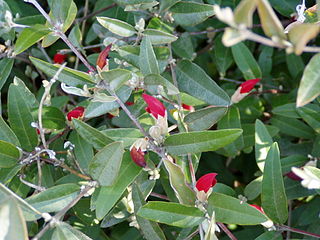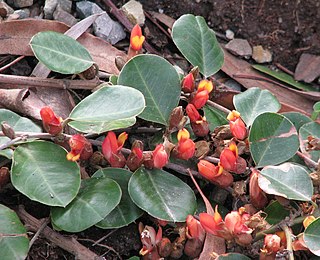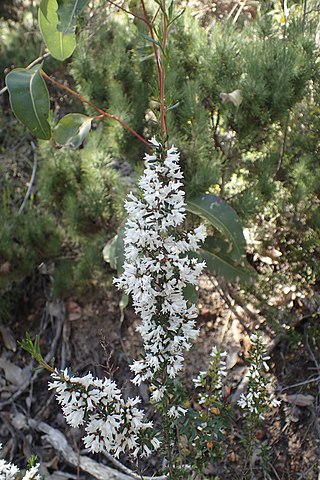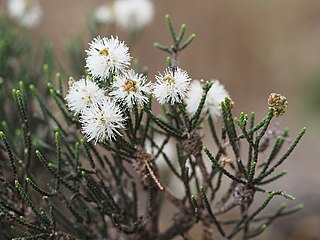
Gastrolobium is a genus of flowering plants in the family Fabaceae. There are over 100 species in this genus, and all but two are native to the south west region of Western Australia.

Mirbelia is a plant genus belonging to the family Fabaceae and is endemic to Australia, occurring in every mainland state except South Australia. Plants in the genus Mirbelia are prickly, perennial shrubs with simple, sometimes sharply-pointed leaves, or the leaves absent. The flowers are arranged singly or in groups in leaf axils or on the ends of branches, the sepals joined at the base with five teeth. The petals are usually red, orange, purplish or bluish and the fruit is an inflated pod.

Gastrolobium melanopetalum is a shrub in the family Fabaceae which is endemic to the south-west of Western Australia.

Gastrolobium praemorsum is a scrambling shrub which is endemic to the south-west of Western Australia. It is a member of the family Fabaceae and produces red pea-flowers from late winter to early summer. It is not known whether this species shares the toxic properties of many other members of the genus Gastrolobium.

Gastrolobium bilobum, commonly known as heart-leaved poison, is a bushy shrub which is endemic to south west Western Australia.

Gastrolobium celsianum, the Swan River pea, is a low-growing shrub which is endemic to Western Australia.

Gastrolobium sericeum is a flowering plant in the family Fabaceae. It is endemic to the south-west of Western Australia. It is a prostrate, low shrub with pendulous yellow, green, red or nearly black pea-flowers from spring to summer.

Gastrolobium grandiflorum, commonly known as wallflower poison, wallflower poison bush or heart-leaf poison bush, is a bushy shrub which is endemic to Australia.

Gastrolobium lehmannii, the Cranbrook pea, is a vulnerable shrub in the family Fabaceae which is endemic to an area of Western Australia.

Gastrolobium minus, also known as broad-leaved brachysema, is a prostrate shrub which is endemic to the south-west of Western Australia. It is a member of the family Fabaceae and of the genus Gastrolobium, which contains many toxic species, however the toxicity of this species is unknown.

Cryptandra arbutiflora, commonly known as waxy cryptandra, is a species of flowering plant in the family Rhamnaceae and is endemic to the southwest of Western Australia. It is a shrub with spiny branches, elliptic to linear leaves and tube-shaped white flowers.

Gastrolobium leakeanum, commonly known as the mountain pea, is a plant in the pea family Fabaceae that is endemic to a small area in the south-west of Western Australia. It is an erect or sprawling shrub to about 2 m high, with red to orange or yellow flowers in spring.

Melaleuca thyoides, commonly known as salt lake honey-myrtle is a plant in the myrtle family, Myrtaceae and is endemic to the south-west of Western Australia. It is an erect shrub with grey, papery or fibrous bark and very small, overlapping leaves on thin branchlets. It is a salt tolerant species often found on the edges of salt lakes.
Grevillea yorkrakinensis is a shrub of the genus Grevillea native to Western Australia.

Darwinia masonii, commonly known as Mason's darwinia is a plant in the myrtle family Myrtaceae and is endemic to Western Australia.

Muiriantha is a genus of plant containing the single species Muiriantha hassellii and is endemic to the south coast of Western Australia. It is a small shrub with branchlets covered sparsely in hairs, leathery leaves and yellowish-green pendulous flowers.

Philotheca gardneri is a species of flowering plant in the family Rutaceae and is endemic to the south-west of Western Australia. It is a shrub with crowded, narrow club-shaped or more or less spherical leaves and white flowers with a prominent pink midrib, usually borne singly on the ends of branchlets.

Gastrolobium rigidum is a small bushy shrub in the pea family (Fabaceae), native to Western Australia.

Gastrolobium villosum is a low spreading shrub in the pea family (Fabaceae), native to Western Australia. Like most Gastrolobiums it is poisonous to stock.

Gastrolobium stenophyllum, commonly known as narrow-leaved poison, is a flowering plant in the family Fabaceae and is endemic to Western Australia. It is a bushy, upright shrub with orange, pink and red flowers. Flowering occurs from September to December or January to February. It grows at the base of outcrops, near rivers, in heath and shrubland and in sandy locations.


















